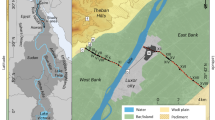Abstract
DURING an expedition made by the Hydrobiological Research Unit of the University of Khartoum in March and April 1958, Eichornia crassipes was encountered in the White Nile and Bahr el Gebel along about 1,000 km. of the river system. Observations were made in part from the Unit's launch (from Khartoum to the Sobat Mouth) and in the southern reaches (from the Sobat Mouth to Juba) from a Sudan Railways steamer. The latter travelled night and day so the southernmost limit of the plant could not be recorded precisely.
This is a preview of subscription content, access via your institution
Access options
Subscribe to this journal
Receive 51 print issues and online access
$199.00 per year
only $3.90 per issue
Buy this article
- Purchase on Springer Link
- Instant access to full article PDF
Prices may be subject to local taxes which are calculated during checkout
Similar content being viewed by others
References
Gay, P. A., Ann. Rep. Hydrobiological Research Unit. University of Khartoum, 4, 10 (1957).
Author information
Authors and Affiliations
Rights and permissions
About this article
Cite this article
GAY, P. Eichornia crassipes in the Nile of the Sudan. Nature 182, 538–539 (1958). https://doi.org/10.1038/182538b0
Issue Date:
DOI: https://doi.org/10.1038/182538b0
This article is cited by
-
Methane fermentation of water hyacinth: effect of solids concentration and inoculum source
Mircen Journal of Applied Microbiology and Biotechnology (1988)
-
Physical and chemical characteristics of the Blue Nile and the White Nile at Khartoum
Hydrobiologia (1984)
-
Permanent swamp vegetation of the Upper Nile
Hydrobiologia (1984)
-
Aquatic snails of the Jonglei region, southern Sudan, and transmission of trematode parasites
Hydrobiologia (1984)
Comments
By submitting a comment you agree to abide by our Terms and Community Guidelines. If you find something abusive or that does not comply with our terms or guidelines please flag it as inappropriate.



